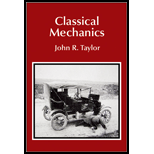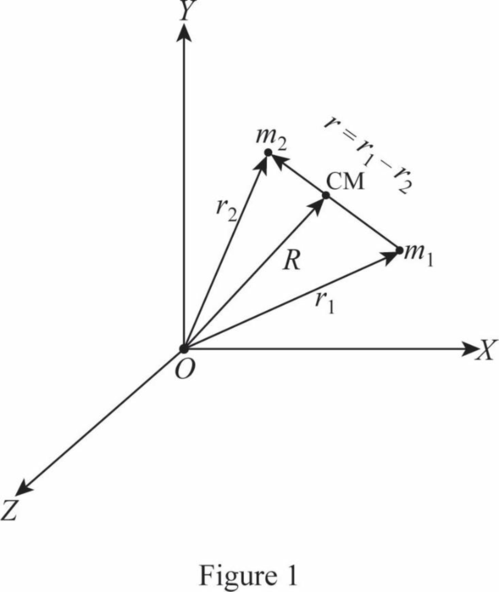
Concept explainers
(a)
Decompose the Lagrange equation into equation 8.13.
(a)
Answer to Problem 8.2P
Lagrange equation is decomposed into equation 8.13.
Explanation of Solution
Write the general expression for position coordinate of centre of mass of system.
Here¸
Write the equation for the total mass of the system.
Draw the vector diagram showing the position vectors of individual masses and centre of mass.

Express
Here,
Rewrite equation (II) by adding
Write the equation for linear velocity of 1st mass from the above equation.
Here,
Rewrite equation (II) by adding
Write the equation for linear velocity of 2nd mass from the above equation.
Here,
Write the expression for total kinetic energy.
Rewrite the above equation by substituting equations (III) and (IV).
Replace
Here,
Write the expression for total potential energy. It is the sum of interaction potential energy due to two masses and the gravitational potential energy.
Here,
Write the equation for
Rewrite the equation for
Write the general form of LaGrange of a system.
Rewrite the above equation by substituting equations (V) and (VI).
Express
Express
Here, x, y, z are relative coordinates.
Rewrite the equation for
Split the Lagrange into two parts-Lagrange of mass
Write the Lagrange of mass
Here,
Write the Lagrange of mass
Here,
So, the total Lagrange can be expressed as follows.
Conclusion:
Therefore, the Lagrange equation is decomposed into equation 8.13.
(b)
Write the Lagrange equation in cartesian coordinates, three Lagrange equation for relative coordinates and prove that the motion is equivalent to that of a single particle of mass equal to that of reduced mass of the system.
(b)
Answer to Problem 8.2P
Lagrange equation in cartesian coordinates are
Explanation of Solution
Write the Lagrange of mass
Write the Lagrange equation in x-direction of centre of mass.
Rewrite the above equation by substituting the previous equation.
Write the Lagrange equation in y-direction of centre of mass.
Rewrite the above equation by substituting
Write the Lagrange equation in z-direction of centre of mass.
Rewrite the above equation by substituting
Above results show that the system is moving at constant speed in x and y direction and is moving downwards with gravitational acceleration.
Write the Lagrange equation in relative coordinate x.
Rewrite the above equation by substituting
Write the Lagrange equation in relative coordinate y.
Rewrite the above equation by substituting
Write the Lagrange equation in relative coordinate z.
Rewrite the above equation by substituting
Conclusion:
Therefore, the Lagrange equation in cartesian coordinates are
Want to see more full solutions like this?
Chapter 8 Solutions
Classical Mechanics
 College PhysicsPhysicsISBN:9781305952300Author:Raymond A. Serway, Chris VuillePublisher:Cengage Learning
College PhysicsPhysicsISBN:9781305952300Author:Raymond A. Serway, Chris VuillePublisher:Cengage Learning University Physics (14th Edition)PhysicsISBN:9780133969290Author:Hugh D. Young, Roger A. FreedmanPublisher:PEARSON
University Physics (14th Edition)PhysicsISBN:9780133969290Author:Hugh D. Young, Roger A. FreedmanPublisher:PEARSON Introduction To Quantum MechanicsPhysicsISBN:9781107189638Author:Griffiths, David J., Schroeter, Darrell F.Publisher:Cambridge University Press
Introduction To Quantum MechanicsPhysicsISBN:9781107189638Author:Griffiths, David J., Schroeter, Darrell F.Publisher:Cambridge University Press Physics for Scientists and EngineersPhysicsISBN:9781337553278Author:Raymond A. Serway, John W. JewettPublisher:Cengage Learning
Physics for Scientists and EngineersPhysicsISBN:9781337553278Author:Raymond A. Serway, John W. JewettPublisher:Cengage Learning Lecture- Tutorials for Introductory AstronomyPhysicsISBN:9780321820464Author:Edward E. Prather, Tim P. Slater, Jeff P. Adams, Gina BrissendenPublisher:Addison-Wesley
Lecture- Tutorials for Introductory AstronomyPhysicsISBN:9780321820464Author:Edward E. Prather, Tim P. Slater, Jeff P. Adams, Gina BrissendenPublisher:Addison-Wesley College Physics: A Strategic Approach (4th Editio...PhysicsISBN:9780134609034Author:Randall D. Knight (Professor Emeritus), Brian Jones, Stuart FieldPublisher:PEARSON
College Physics: A Strategic Approach (4th Editio...PhysicsISBN:9780134609034Author:Randall D. Knight (Professor Emeritus), Brian Jones, Stuart FieldPublisher:PEARSON





